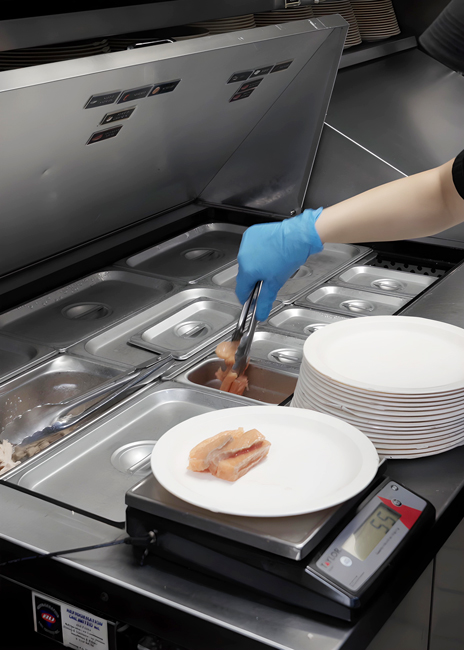Food safety has always been an issue with consumers, but with the recent Netflix documentary, “Poisoned: The Dirty Truth About Your Food,” the subject may jump back into the public’s consciousness.
While not strictly about foodservice, the documentary details some tragic food safety-related incidents, such as the 1992-93 E. coli outbreak in the Pacific Northwest that was traced to hamburgers served at a fast-food chain. The outbreak infected hundreds of people and was directly traced to at least four fatalities. With food safety back in the public spotlight — at least temporarily — it’s a good time to rethink it. Double-checking basic procedures is a start, but creating a culture around food safety represents a better way to ensure compliance and reduce risk. Here are some different perspectives on how to best create an environment that promotes a focus on food safety.
The Trainer
 Mary Angela MillerMary Angela Miller, owner and principal of Columbus, Ohio-based KeepSafe Food, started out in healthcare foodservice, where she took a memorization-based approach to food safety education. To help employees pass certification tests, she developed a series of 500 flash cards with food safety facts. On the commercial side these days, however, she goes for a more personal approach. “I do it with stories,” Miller describes. “I ask my class or whoever’s in the training to share a story. It’s amazing what they’ll come up with. And hopefully that will stick with them longer than the facts, because you can always look up the facts, but you have to remember why you’re doing this.” She cites the example of a plastic beverage cup being used as a substitute for a scoop in an ice machine. “They’re not safe; they will shatter. And then you have plastic pieces that you cannot distinguish from the ice. You scoop that ice, put it in the beverage and serve it to our customer. I’ve seen that happen,” she admits. Sharing a story like that, she feels, is stronger than simply teaching from a text.
Mary Angela MillerMary Angela Miller, owner and principal of Columbus, Ohio-based KeepSafe Food, started out in healthcare foodservice, where she took a memorization-based approach to food safety education. To help employees pass certification tests, she developed a series of 500 flash cards with food safety facts. On the commercial side these days, however, she goes for a more personal approach. “I do it with stories,” Miller describes. “I ask my class or whoever’s in the training to share a story. It’s amazing what they’ll come up with. And hopefully that will stick with them longer than the facts, because you can always look up the facts, but you have to remember why you’re doing this.” She cites the example of a plastic beverage cup being used as a substitute for a scoop in an ice machine. “They’re not safe; they will shatter. And then you have plastic pieces that you cannot distinguish from the ice. You scoop that ice, put it in the beverage and serve it to our customer. I’ve seen that happen,” she admits. Sharing a story like that, she feels, is stronger than simply teaching from a text.
Miller notes that food safety is more important than ever with customers because “there is a change, whether we realize it or not” since the pandemic. Of the “big six” pathogens most associated with food safety issues, “two of those are viruses — norovirus and hepatitis A,” she explains. “And because the coronavirus was a virus, we learned a lot about virus transmission, and I think that translated to the general public.” There are some upsides to this increased awareness, such as the continued use of hand sanitizer dispensers in restaurants, Miller adds. “So some of the good habits that we developed during COVID are here to stay, and I think they can only help.”
The constant turnover and other labor issues foodservice regularly faces are second nature to Miller. “That’s a challenge that I always had as a foodservice director in a hospital operation because people would come to us and often move up and out quickly,” she says. “I think now it’s just exacerbated throughout the rest of the industry.” To cope with the constant turnover, she says, “You have to make it as simple as possible to keep food safe. That’s our responsibility. You give people the tools and the facility to make it easy to keep food safe so they don’t have to reinvent the wheel every day.” Part of that, she adds, includes making everything as simple as possible for employees. “You put signs up about what you do here, you clear the path and you make sure they have the right equipment.”
For the occasional food safety problem that does pop up, Miller suggests taking a page from the healthcare industry’s playbook. “We had checklists. You have a checklist, say, before surgery where an X marks the spot of the surgery, and you go around and everyone knows that’s the arm we’re going to operate on. The checklist takes away the ‘whose responsibility’ or ‘who’s to blame’ when something goes wrong,” she explains. In foodservice, inevitably, something will go wrong, “but you don’t want to place blame,” she says. “You really have to have a good debriefing process, identify what went wrong and what you can do better the next time — or what you need to implement that didn’t happen.”
The Operator
 Troy HooperTroy Hooper is the CEO of Hot Palette North America, the franchisor parent company of Pepper Lunch. Pepper Lunch is a fast-casual chain that specializes in Japanese teppanyaki-style cooking, where ingredients are cooked on a 500-degree-F hot plate. The chain has five units domestically and also has one unit each in Guam and Canada.
Troy HooperTroy Hooper is the CEO of Hot Palette North America, the franchisor parent company of Pepper Lunch. Pepper Lunch is a fast-casual chain that specializes in Japanese teppanyaki-style cooking, where ingredients are cooked on a 500-degree-F hot plate. The chain has five units domestically and also has one unit each in Guam and Canada.
All Pepper Lunch franchisees go through training that includes food safety education. Each store has an on-site manager, who goes through even more thorough training. And every employee goes through a total training program, of which food safety is a significant component. Because much of the food the chain serves is handled raw and finished on the hot plate, “we obviously have a high sensitivity to food safety,” explains Hooper. Rice is the one item actually cooked in the kitchen at Pepper Lunch, and Hooper says the company plans to switch its rice cooker brand to a model that “the team can actually confidently clean and keep hygienic,” he says.
By its very nature, the business model for Pepper Lunch avoids common food safety hazard points, admits Hooper. Most of the food products the chain uses are refrigerated or frozen and “come in the door from vendors already sliced, diced, chopped and completely prepped,” Hooper says. “So we don’t actually do any food prep on-site, which eliminates the variable of human error in regard to proper defrosting [and] handling of cutting boards, knives and gloves — all those touch points that could be a threat to food safety.” Soy sauce, which can be made in facilities that also process other foods, is the only potential allergenic product at Pepper Lunch.
 Pepper Lunch feels the chain lessens potential food safety issues by using pre-prepped ingredients.The chain’s corporate quality control department inspects its supply chain partners and any potential new vendors to ensure compliance with all health regulations. Pepper Lunch will soon begin working with an outside monitoring service to visit stores unannounced and do spot inspections to “ensure a standard of cleanliness and also identify potential concern areas where we may have to address retraining or even products and processes,” Hooper says. Once the program begins, Pepper Lunch plans to promote it to consumers in marketing materials and on-site.
Pepper Lunch feels the chain lessens potential food safety issues by using pre-prepped ingredients.The chain’s corporate quality control department inspects its supply chain partners and any potential new vendors to ensure compliance with all health regulations. Pepper Lunch will soon begin working with an outside monitoring service to visit stores unannounced and do spot inspections to “ensure a standard of cleanliness and also identify potential concern areas where we may have to address retraining or even products and processes,” Hooper says. Once the program begins, Pepper Lunch plans to promote it to consumers in marketing materials and on-site.
On a more day-to-day operational level, the chain uses sanitation checklists that it requires staff to complete and turn in to the supervisor or manager on duty. But the chain has plans to move to a digital checklist system within the next six months, says Hooper. Staff will have to complete the checklist as part of their daily duties “and any miss on one of those items would be a red flag in the digital system and would be seen on the manager’s cell phone or [computer] dashboard,” he explains.
To further create awareness about food safety practices, Pepper Lunch works with an outside vendor to provide an interactive training program for employees that delivers information in the form of quizzes, memes, videos and podcasts. “You have to engage them in a way that is interesting to them,” Hooper says.
The Industry Expert
 Patrick GuzzleAny attempt to establish a culture of food safety has to start at the top, says Patrick Guzzle, vice president of food science and industry for the National Restaurant Association. “I can think of a few examples I’ve seen where as high as the CEO is invested in food safety and making sure that the employees, the shift managers and everybody is invested in food safety,” he says. That emphasis on food safety has to be practiced “throughout your daily tasks, just showing everybody that food safety is just part of what we do. It’s part of our organization,” Guzzle describes.
Patrick GuzzleAny attempt to establish a culture of food safety has to start at the top, says Patrick Guzzle, vice president of food science and industry for the National Restaurant Association. “I can think of a few examples I’ve seen where as high as the CEO is invested in food safety and making sure that the employees, the shift managers and everybody is invested in food safety,” he says. That emphasis on food safety has to be practiced “throughout your daily tasks, just showing everybody that food safety is just part of what we do. It’s part of our organization,” Guzzle describes.
Guzzle believes that top-down emphasis can help alleviate the issues that sometimes come up with a constantly shifting staff. When everyone in the company keeps a focus on food safety, that emphasis can transfer to new staff members, he says. “A brand-new employee may not be familiar with all the processes, but they’re going to look around and realize, ‘The food safety expectations are there, and I’m seeing everybody doing them. I’m seeing even the CEO or the business owner washing their hands or checking temperatures, and they’re vested in it too.’”
Some of the more stringent food safety practices that were in place during the pandemic may now have relaxed, Guzzle says. “During the pandemic, I think more consumers were probably thinking about food safety,” he says. “And as we’ve kind of gone back to normal, I think we’re reverting to some of our prior habits and prior thought processes.” But operators still need to be mindful because errors can occur, and Guzzle says they need to be caught as quickly as possible and turned into a learning experience. “When we notice [a problem], we have to stop and correct it right then. That sets the example. But this now presents an opportunity for management to work with that employee. Work with that person to reemphasize the importance of food safety and do a little bit of retraining. Mentor them so that they recognize the mistake that was made and then they can see the correction.”
Putting a personal spin on food safety is another technique Guzzle says can be effective with staff. Thinking about the worst-case scenarios that can occur with food safety crises can bring home the importance of following all food safety precautions. “If we imagine that our guests are our family, then I think we can really increase our food safety efforts because we would not do anything to intentionally harm our family,” he says. And taking it to an even more serious level can also be impactful with staff, Guzzle adds. “If we think about the importance of what we’re doing when we serve food, I think that also helps increase the level of concern we ought to be putting in in terms of food safety,” he says. “We might think [our actions] are minor, but they can result in harm and maybe even the death of a person just from eating a hamburger. I frequently tell my team that we know we cannot prevent every single case of a foodborne illness, but today we want to prevent one more.”



